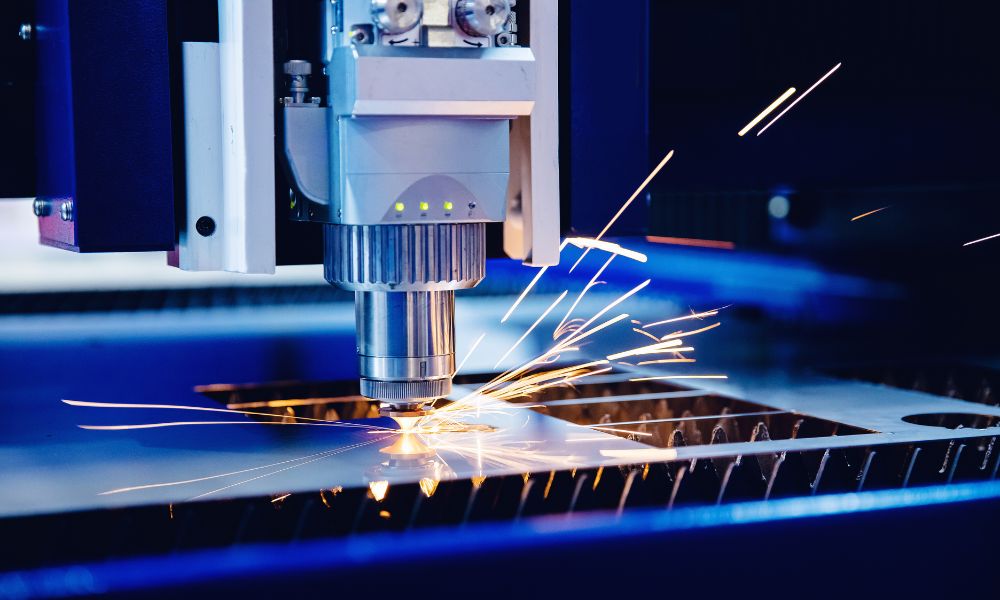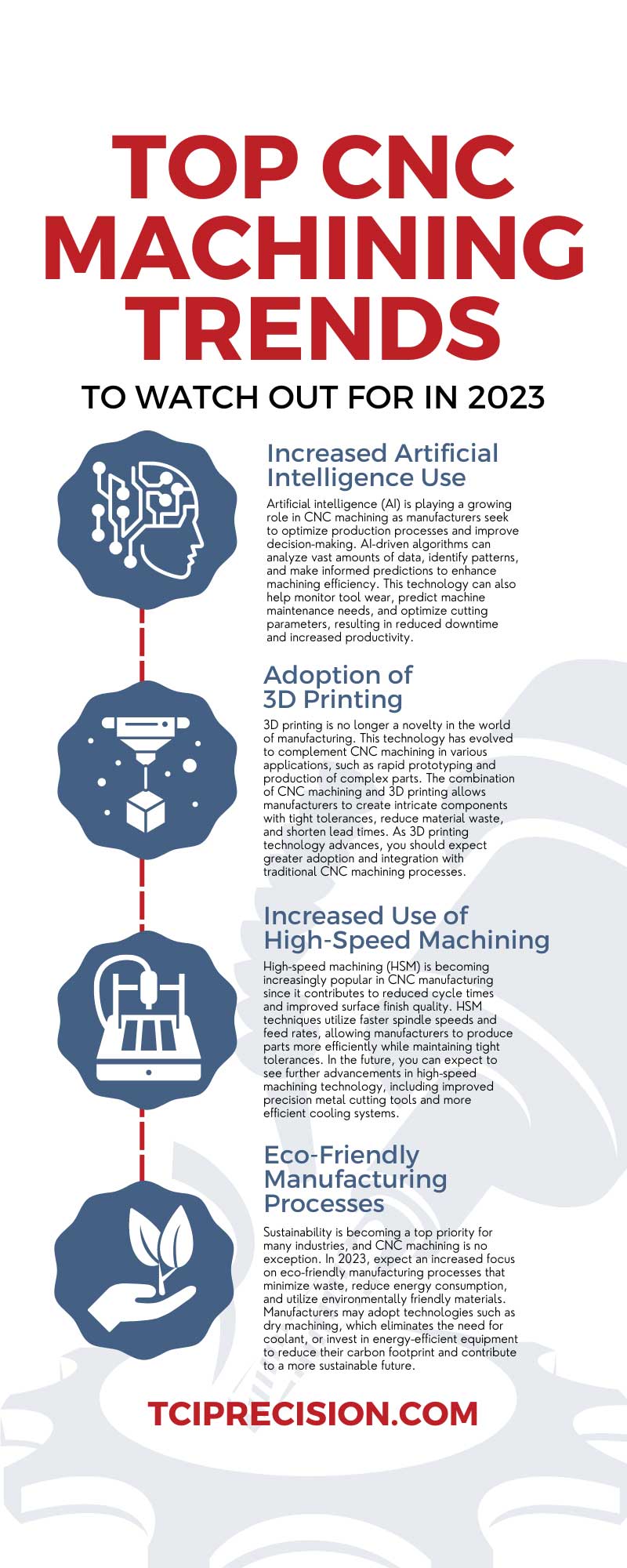Top 12 CNC Machining Trends To Watch Out for in 2023
The CNC machining industry continues to evolve, driven by advancements in technology, growing demand, and a focus on sustainability. Manufacturers are constantly seeking new ways to increase efficiency, reduce costs, and remain competitive in the global market.
To help you stay informed and ahead of the curve, we’ve compiled a list of the top 12 CNC machining trends to watch out for in 2023. From automation and IoT to eco-friendly processes and advanced materials, these trends are shaping the future of CNC machining.
Automation and Robotics Integration
Automation and robotics continue to be a significant trend in CNC machining as companies strive for increased efficiency and reduced labor costs. The integration of robots and automated systems in the manufacturing process allows for consistent production quality, faster cycle times, and reduced human error. As robotics technology advances, you can expect to see further improvements in CNC machining processes, including streamlined material handling and better machine-to-machine communication. As automation continues to grow, the need for consistent materials also grows. Material that is consistent in all-around dimensions, part-to-part, streamlines part placement, and loading and unloading by robots or cobots.
Increased Artificial Intelligence Use
Artificial intelligence (AI) is playing a growing role in CNC machining as manufacturers seek to optimize production processes and improve decision-making. AI-driven algorithms can analyze vast amounts of data, identify patterns, and make informed predictions to enhance machining efficiency. This technology can also help monitor tool wear, predict machine maintenance needs, and optimize cutting parameters, resulting in reduced downtime and increased productivity.
Adoption of 3D Printing
3D printing is no longer a novelty in the world of manufacturing. This technology has evolved to complement CNC machining in various applications, such as rapid prototyping and production of complex parts. The combination of CNC machining and 3D printing allows manufacturers to create intricate components with tight tolerances, reduce material waste, and shorten lead times. As 3D printing technology advances, you should expect greater adoption and integration with traditional CNC machining processes.
Expansion of Hybrid Manufacturing
Hybrid manufacturing combines additive and subtractive manufacturing methods to create a seamless, efficient production process. This trend enables manufacturers to produce parts that were previously impossible or extremely difficult to create using traditional methods alone. By integrating CNC machining with technologies like 3D printing and laser cladding, manufacturers can reduce material waste, increase production speed, and create complex geometries with high precision.
Advancements in Multi-Axis Machining
Multi-axis machining has been gaining traction in recent years due to its ability to produce complex parts with high precision and reduced setup times. As the technology continues to advance, manufacturers can now utilize 5-axis and even 6-axis machines to create intricate components faster and more efficiently. This trend is expected to continue in 2023, as more industries recognize the benefits of multi-axis machining and invest in the necessary equipment.
Increased Use of High-Speed Machining
High-speed machining (HSM) is becoming increasingly popular in CNC manufacturing since it contributes to reduced cycle times and improved surface finish quality. HSM techniques utilize faster spindle speeds and feed rates, allowing manufacturers to produce parts more efficiently while maintaining tight tolerances. In the future, you can expect to see further advancements in high-speed machining technology, including improved precision metal cutting tools and more efficient cooling systems.
IoT and Industry 4.0 Integration
The Internet of Things (IoT) and Industry 4.0 are driving a new era of connectivity and data-driven decision-making in CNC machining. By integrating sensors, smart devices, and advanced software, manufacturers can monitor machine performance, track production data, and optimize processes in real-time. This trend shows no signs of stopping, as companies invest in IoT and Industry 4.0 technologies to stay competitive and improve overall manufacturing efficiency.
Development of Advanced Materials
As industries demand higher performance and more durable components, there is a growing need for advanced materials in CNC machining. These materials, such as advanced ceramics, composites, and high-performance alloys, offer improved strength, durability, and wear resistance compared to traditional materials.
As time goes on, you can expect more research and development focused on creating advanced materials that can withstand extreme conditions and improve the performance of CNC-machined parts.
Enhanced Machine Tool Monitoring
Machine tool monitoring is becoming increasingly important for CNC machining, as it helps manufacturers identify issues, optimize processes, and reduce downtime. Advanced monitoring systems can track various machine parameters, such as spindle load, vibration, and temperature, to identify potential problems before they escalate.
In the future, you’ll likely see more sophisticated monitoring systems that can predict maintenance needs, improve machining accuracy, and increase overall productivity.
Eco-Friendly Manufacturing Processes
Sustainability is becoming a top priority for many industries, and CNC machining is no exception. In 2023, expect an increased focus on eco-friendly manufacturing processes that minimize waste, reduce energy consumption, and utilize environmentally friendly materials. Manufacturers may adopt technologies such as dry machining, which eliminates the need for coolant, or invest in energy-efficient equipment to reduce their carbon footprint and contribute to a more sustainable future.
Virtual Reality and Augmented Reality Applications
Virtual Reality (VR) and Augmented Reality (AR) technologies are starting to make their mark on CNC machining, offering new ways to improve training, design, and collaboration. VR can create immersive environments for training operators, allowing them to practice their skills in a safe and controlled setting.
AR can overlay digital information onto the physical world, helping operators visualize complex data and make better-informed decisions during the machining process. We predict that these technologies will become more prevalent in the CNC machining industry, enhancing productivity and efficiency.
Data-Driven Decisions
In 2023, data-driven decision-making is expected to become even more critical in the CNC machining industry. The increasing availability of data from connected machines and sensors, combined with advanced analytics and AI, enables manufacturers to make better-informed decisions about their processes.
By harnessing this data, manufacturers can optimize their machining processes, predict maintenance needs, and improve overall efficiency. This trend will continue to grow as more companies recognize the value of data-driven insights and invest in the necessary technology to collect, analyze, and act on this information.
Now that you know the top CNC machining trends to watch out for in 2023, you’re well-equipped to stay ahead of the competition and make the most of emerging opportunities in the industry. By embracing automation, IoT, data-driven decision-making, and eco-friendly processes, you can increase efficiency, reduce costs, and maintain a competitive edge in a constantly evolving market.


